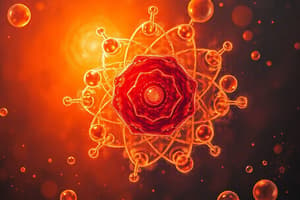Podcast
Questions and Answers
What is the value of Planck's constant?
What is the value of Planck's constant?
6.63 × 10–34 Js
What is the velocity of light?
What is the velocity of light?
3.0 × 10^8 ms–1
If uncertainty in position and momentum are equal, then uncertainty in velocity is?
If uncertainty in position and momentum are equal, then uncertainty in velocity is?
h/m
What is the total number of atomic orbitals in the fourth energy level of an atom?
What is the total number of atomic orbitals in the fourth energy level of an atom?
Two atoms are said to be isobars if they have the same __________.
Two atoms are said to be isobars if they have the same __________.
Match the following programming languages with their primary usage:
Match the following programming languages with their primary usage:
What is the value of Planck's constant?
What is the value of Planck's constant?
What is the velocity of light?
What is the velocity of light?
What is the frequency of radiation emitted when the electron falls from n = 4 to n = 1 in a hydrogen atom?
What is the frequency of radiation emitted when the electron falls from n = 4 to n = 1 in a hydrogen atom?
If uncertainty in position and momentum are equal, then uncertainty in velocity is?
If uncertainty in position and momentum are equal, then uncertainty in velocity is?
What is the correct set of four quantum numbers for the valence electron of rubidium atom (Z = 37)?
What is the correct set of four quantum numbers for the valence electron of rubidium atom (Z = 37)?
The pair of ions having the same electronic configuration is __________.
The pair of ions having the same electronic configuration is __________.
Match the following quantum numbers with the information provided:
Match the following quantum numbers with the information provided:
Match the following statements regarding isotopes:
Match the following statements regarding isotopes:
Number of angular nodes for 4d orbital is __________.
Number of angular nodes for 4d orbital is __________.
Flashcards are hidden until you start studying
Study Notes
Atomic Structure Concepts
- Energy levels in hydrogen atoms change based on electron transitions, with lower energy transitions yielding less energetic photons.
- Planck’s constant is 6.63 × 10⁻³⁴ Js; velocity of light is 3.0 × 10⁸ m/s, aiding in wavelength calculations through frequency.
- Ionization energy for hydrogen is 2.18 × 10⁻¹⁸ J atom⁻¹, used to derive emission frequencies from electron transitions.
- Uncertainty principle relates to simultaneous knowledge of position and momentum, affecting velocity calculations.
- Fourth energy level contains eight atomic orbitals, with various configurations of electrons.
Quantum Numbers and Electron Configuration
- Quantum numbers define electron positions: principal (n), azimuthal (l), magnetic (m), and spin (s).
- Electron orbitals accommodate electrons according to Pauli's Exclusion Principle, with specific configurations representing ground states.
- Hydrogen spectrum emissions are influenced by electron transitions through defined series such as Lyman and Balmer.
Energy Levels and Transitions
- For transitions in hydrogen, wavelengths emitted can be determined; transitions from high to low energy levels usually produce visible light.
- Isobars are defined as atoms with the same mass number but differing atomic numbers.
- In multi-electron atoms, subshells have varied energies due to electron-electron interactions and shielding effects.
Theories of Atomic Structure
- Thomson’s model describes atoms with uniformly distributed positive charge, while Rutherford's model introduces a concentrated nucleus.
- Bohr's model applies to hydrogen-like atoms, where orbital energies and associated spectra can be calculated.
- Cathode rays' properties reveal information about atomic structure, demonstrating independence from electrode material and straight-line motion.
Important Principles
- Hund’s Rule states that electrons fill orbitals singly before pairing.
- Heisenberg’s Uncertainty Principle articulates the limitations in measuring electron position and momentum.
- Electron configurations dictate chemical properties and reactivity based on the arrangement of electrons across orbitals.
Assertion Reasoning and Relationships
- Statements about electrons’ behavior must differentiate between correct assertions and the rationale behind them, impacting our understanding of atomic structure.
- Angular momentum quantization and node characteristics in orbitals define stability and energy arrangement within atoms.
- Understanding energy levels and transitions provides insights into spectral analysis and atomic behavior in various states.
Spectroscopic Series
- Series like Lyman and Balmer showcase the relationship between electron transitions and emitted wavelengths, relevant for spectroscopy.
- Each series corresponds to different transitions: Lyman (n ≥ 2 to n = 1), Balmer (n ≥ 3 to n = 2), with specific wavelengths vital for understanding atomic emissions.
Quantum Mechanics Implications
- The acceptance of quantum mechanics reshaped atomic theory, emphasizing electron wave-particle duality and probabilistic behavior over deterministic pathways.
- Agreements and contradictions between experimental data (like Rutherford's findings) and theoretical models prompt continuous evolution in atomic and quantum theories.### Quantum Mechanics Assertions and Reasons
- Maximum value of magnetic quantum number ( m ) for an electron in the third energy level is 3; the maximum value of angular momentum quantum number ( l ) for that energy level is 2.
- Black body is defined as an ideal radiator/absorber of electromagnetic radiation across all frequencies, while its radiation behavior can be explained using quantum theory.
- Isotopes of an element showcase similar chemical behavior due to identical electron structures, although they differ in mass.
- Kinetic energy (K.E.) of two subatomic particles varies even if their de-Broglie wavelengths are the same; wavelength is inversely related to mass.
- Angular momentum of an electron is quantized, meaning only specific orbits are allowed where momentum equals a natural number multiple of ( h/2\pi ).
Evaluation Options for Assertions and Reasons
- Understanding the correctness of assertions and explanations can be categorized:
- Both assertion and reason are correct, and the reason explains the assertion.
- Both assertion and reason are correct, but the reason does not explain the assertion.
- The assertion is true, while the reason is false.
- The assertion is false, whereas the reason is true.
Key Facts Reference
- For black body radiation, quantum theory offers a pivotal explanation of emission and absorption mechanics.
- Isotopes maintain the same electron configuration leading to similar chemical properties despite differing neutron counts.
- The relationship between mass and de-Broglie wavelength is fundamental in quantum mechanics, indicating that K.E. can differ even with similar wavelengths.
- Angular momentum quantization is a core principle in atomic physics, dictating the allowed energy states for electrons.
Studying That Suits You
Use AI to generate personalized quizzes and flashcards to suit your learning preferences.




